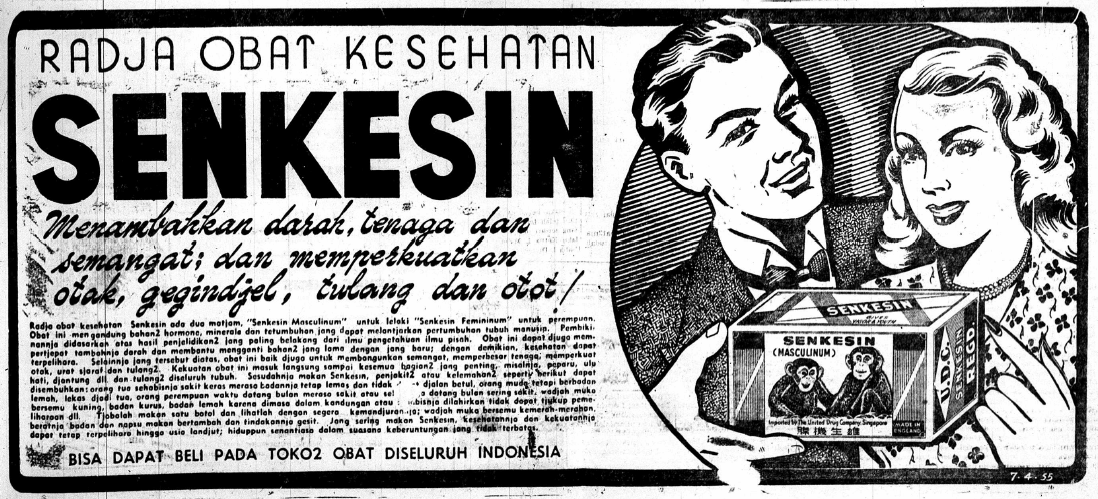I have posted a couple of entries about the medicine Sinkesin (here and here). I first came across it in a Thai newspaper from the 1930s, and then in a Chinese newspaper from Burma in the 1950s.
Now I have found it (under the name Senkesin) in an Indonesian newspaper from the 1950s called Waspada. I don’t know Indonesian, but the images in this advertisement are the clearest that I have found for this product.
If someone would like to read what it says and tell me the gist of it, that would be wonderful.
What is great about this add is that we can finally get a good view of the monkeys. The Thai advertisement from the 1930s which I read said that the main ingredient in Sinkesin came from the sex glands of langurs. The two cute guys in the picture here, however, look like chimpanzees.
In any case, it is great to finally see the Latin term for this secret medicinal ingredient – Masculinum!




This Post Has 4 Comments
Very interesting post for our family as our grandfather was the founder & proprietor of the United Drug Company.
The story told to us was that this potion started life as a “tonic” in Germany (not England), neither country known for its population of Langurs, shipped to Hong Kong and repackaged with this fancy name. We can be fairly certain that no langurs were harmed or conscripted for this elixir of youth and vitality.
Thank you very much for this information!! Yes, I always had my doubts that anything in this medicine actually came from a langur, but your story of how it was produced is more fascinating than I imagined. Over the year I repeatedly found advertisements for Sinkesin, so in terms of advertising, the company was very active. But whatever became of Sinkesin? Do you know? I would love to find out.
I will translated it but maybe not 100% accurate since my native language is Bahasa Indonesia (I translate in from word to word, but as we know, the English language and Indonesia one has different system etc). also my basic knowledge is engineering not chemistry or pharmaceutical
Here the translation :
King of medicinal drug, Senkesin there are two kind “Senkesin Masculinoum” for man and “Senkesin Feminum” for woman. This drug contain ingredients like hormone, minerals and herbs that can accelerate human body growth. This drug production based on latest research knowledge from chemistry science(1). This drug also can use for blood booster and replacing new cell with the old one, because of this, the health is maintained. Other than those mentioned above, this drug is good use for raise the spirit, increase power, strengthen brain, nerve and bones. The power of this drug direct entering important organs like lungs, liver, heart, bones all over body. After consume Senkesin, illness and weakness like the following can be cured : old people after seriously ill feeling the body very weak and cannot walking properly, young but have weak body, woman during menstruation feeling sickness, or ——(2) menstruation often hurts, yellowed face(3), skinny body, weak body because pregnant or after giving birth didn’t get proper care etc. Try to consume one bottle and see the efficacy and you can see quickly : red blushing face(4), increasing body weight, increase appetite, agile movement. For who often consume(5) Senkesin, health and power maintained until old age live always in an atmosphere of unlimited luck
=================================
some notes of the translation and article :
This text contain Indonesia old spelling system the Republics spelling system or Suwandi spelling system (Ejaan Suwandi in Bahasa Indonesia), so some word maybe untranslated with modern translator, this text also contain some archaic or not common in modern Indonesia,
1. Ilmu pisah in the text is to chemistry but in Indonesia modern language it is not used and likely it is archaic term. Chemistry in modern language is “Ilmu Kimia” while Ilmu Pisah is derived from Dutch language Compound of ilmu (“science”) + pisah (“to separate”), calque of Dutch scheikunde (“chemistry”, literally “knowledge to separate”). usually some loan word from like direct translation of other language
2. —- unrecognisable maybe setelahnya (after) or selamanya (during)
3. “wajah bersemu kuning” this term usually used to refer people with condition of serious illness like hepatitis, lever etc. because bilirubin etc. the face and skin get yellowed.
4. wajah bersemu merah terms is same like merah merona (in modern Bahasa) likely this term usually to refer people with healthy sign, had high spirit an passion etc. not look pale (wajah pucat) or yellowed (wajah kuning)
5. “makan” in Bahasa Indonesia translated in English as “eat” but in this text is actually used for to consume. In some sense, if people take medication usualyy used world “meminum obat” thta roughly translated as “drink medicine” or makan obat (eat medicine)
Thank you hope it is helping
Thank you very much for doing this!!!!
And thank you for adding those notes. It makes sense that you would have different spellings and different terms used at that time, so it is interesting to see the examples of that.
Seeing all of the good things Senkesin can do, it makes me want to try it. . . 😉
Thank you again for doing this!!!